35 epic places to visit in Cornwall (updated for 2024)
Are you looking for the best places to visit in Cornwall? From the most beautiful beaches to its charismatic towns, here’s a full list of the very best locations that you can’t miss!
The best places to visit in Cornwall include St Ives, Newquay, Bodmin Moor, Land’s End and mythical Tintagel.
I come from a long line of Cornish ancestors and have always had family in Camborne, so I’ve been a frequent visitor throughout my whole life.
But in the last three years, I’ve got more in touch with my Cornish heritage and have spent months at a time in the region, visiting virtually every town and many villages and I’m well on my way to walking past every single beach!
This blog post is a full list of the very top places to visit in Cornwall; put together by the vast amount of time I’ve spent here.
Whether you’re looking for the most beautiful places in the Duchy or some local secrets and hidden gems, you’ll find it all in this article!
What are the best places to visit in Cornwall?
Here are some of my top places to visit in Cornwall:
- Tintagel: I love the coastline here, along with the fascinating castle.
- Port Isaac: for the Doc Martin connections, of course!
- Bodmin Moor: it’s brooding and encapsulating, and is a refreshing change from the busy coastal towns.
- Padstow: known for its connections to Rick Stein, but my favourite thing about this coastal town is the Camel Estuary.
- St Ives: it’s Cornwall’s top tourist town for a reason!
- Land’s End: the landmark attraction is over-touristy, but the coastline around Land’s End is well worth hiking around.
- Mousehole: possibly the most charming fishing village in the Duchy.
- Truro: Cornwall’s capital, it’s the ultimate place to visit for Cornish culture and heritage.
- Falmouth: this is my favourite town in Cornwall – it has an incredible vibe!
- Polperro: another glorious fishing village with fascinating smuggling connections.
- The Rame Peninsula: this is my favourite hidden gem in Cornwall.
- Launceston: Cornwall’s old county town, this is a must-visit for anyone who’s into history.
Let’s go into these places, and other top spots in Cornwall, in more detail!
Where to go in Cornwall: My top places!
Here’s my full list of where to go in Cornwall, roughly starting in the northeast of the region, by the border with Devon, and travelling around in an anticlockwise direction.
1. Hartland Heritage Coast

Let’s start with one of my favourite hidden gems!
The Hartland Heritage Coast borders Devon, and it’s a remote place that is usually only visited by the most adventurous travellers to Cornwall!
There are two ways to visit the Hartland Heritage Coast. You can either hike from Hartland Quay (in Devon) or Morwenstow (the first village of Cornwall) on the South West Coast Path, taking in the intricacies of the cliffs and watching them tumble into tiny coves.
You’ll see spots like Hawker’s Hut, which is where Robert Stephen Hawker, a local clergyman and poet, used to come to write. He was the songwriter behind Trelawny, which is the unofficial Cornish national anthem!
Alternatively, you can drive to places like Welcombe Mouth Beach (which is technically in Devon, but only just!) and Morwenstow and explore the immediate coastline around these areas.
We hiked from Hartland Quay to Bude on our South West Coast Path adventure – it was the toughest hike we did on the entire trail, but was definitely one of the most scenic!
2. Bude

Beautiful Bude is a popular surf town not too far from the border with Devon. Its long sandy beach and relaxed culture make it one of the best places to go in Cornwall.
Its main two beaches, Summerleaze and Crooklets, both have a variety of breaks, often suitable for beginners but sometimes with waves challenging enough for more experienced surfers. Bude Sea Pool is a free-of-charge spot for safe swimming.
While in town, don’t miss visiting Bude Castle, a historic property which now acts as the town’s history museum, and Bude Canal, which stretches into the countryside.
The main reason I visit Bude is for hiking. Along with the challenging trek to Hartland Quay, you can also walk to Crackington Haven or Bostcastle from Bude.
Think towering cliffs, views across the crashing Atlantic Waves and hidden sandy beaches. Hiking in Cornwall‘s north east is a beauty!
How to get there: Bude is connected to Plymouth and Exeter by (infrequent) buses, and there is another (also infrequent) connection to Boscastle and Tintagel. However, I’d highly recommend driving; for all of North East Cornwall’s draws, a reliable public transport network is alas not one of them!
3. Widemouth Bay

From Bude, head on down to Widemouth Bay, an expansive beach that’s ever-popular with surfers!
Widemouth Bay is more or less an extension of Bude, with a beachside cafe and a caravan park. But in Widemouth, the surf’s always up, and when the sun’s shining you’ll feel like you’re on the East Coast of Australia.
If you’re new to surfing, Widemouth’s a wonderful place to learn.
How to get there: The 95 bus connects Bude with Widemouth Bay; it only runs once every two hours, but it’s a fairly easy (for this part of Cornwall, at least) 3 mile/ 5km walk one way, so you could take the bus and then walk back. It’s only a 7 minute drive from Bude centre.
4. Crackington Haven

One of the quieter beaches on this list, Crackington Haven is popular with geology students due to the unique layers of sandstone which are part of the Crackington Formation. There used to be lots of fossils in the area, but they have been over-collected so are difficult to come by nowadays.
However, it’s one of the best places in Cornwall for rock pooling – visit during low tide to spot crabs and shells in the pools.
A small community lives in Crackington Haven (there’s also a Middle Crackington and Higher Crackington!); but generally, it’s a quiet spot, frequented by rock enthusiasts and hikers (the Crackington Haven to Boscastle walk is one of my favourites on the South West Coast Path).
How to get there: The ubiquitous 95 bus runs through the town every two hours; although we once waited so long for this that we gave up and ended up taking a taxi to Bude, which cost £30! Unfortunately, driving is also the easiest way to access Crackington Haven.
5. Boscastle

Boscastle will enchant you from the second you drive into its inlet.
Run by the National Trust, the village is divided by the River Valency, with quaint cottages and shops on each side.
Ultimately, Boscastle leads to the natural harbour, one of the most dramatically breathtaking natural spots in all of Cornwall. Enjoy it from ground level, and climb up the cliffs on either side to take in the view from above!
Boscastle is also home to the somewhat spooky Museum of Witchcraft and Magic, where you can learn about the village’s mythology and legendary connections.
Check out my full Boscastle blog post by clicking here.
How to get there: Either drive or take the good old every-two-hour 95 bus from Tintagel or Bude!
6. Tintagel

A petite village bursting with history, Tintagel is crowned by the almighty Tintagel Castle – definitely one of the most historic places to visit in Cornwall.
This English Heritage-owned castle is said to be the birthplace of King Arthur, and just underneath it, you’ll find the enigmatic Merlin’s Cave.
Whether you believe the legendary connections or not, Tintagel Castle’s factual history is just as fascinating. It was once the seat of Cornish kings, and ruins have been found in the castle from Spain and France, nodding to prehistoric trade between Cornwall and European countries.
Once you’ve explored the castle (see below for my video with some of my budget hacks for doing so!), see the rest of the village!
Highlights include the Medieval Post Office, the multi-sensory experience of King Arthur’s Great Halls and drinking at Ye Olde Malthouse Inn, a 14th-century pub.
Click here for my full Tintagel guide.
How to get there: It’s the last stop on the 95 bus route from Bude, or there are plenty of car parking spaces – although if you’re visiting in the peak summer season, I’d recommend arriving early to secure your spot.
7. Port Isaac
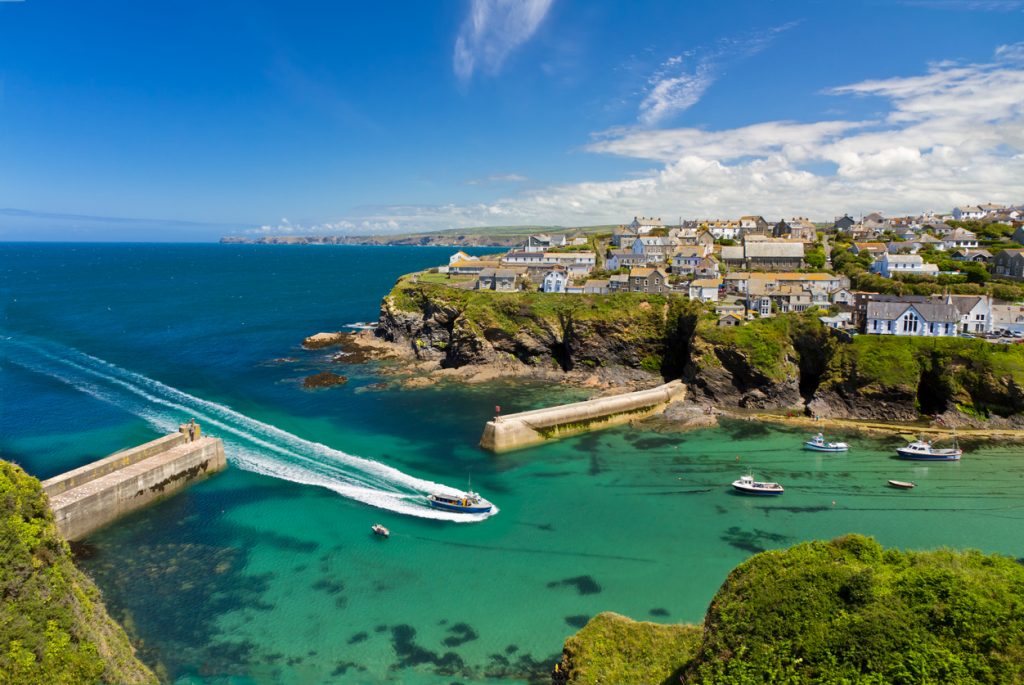
One of Cornwall’s most quaint seaside villages, Port Isaac began its life as a very isolated fishing settlement, accessible only by boat.
Nowadays it’s a tourist hub (not many people live in the village itself; although there is a population living in the “new village” above), but its horseshoe-shaped harbour and historic fishing cottages ensure that it’s still charming even on its busiest days!
While it’s one of the most beautiful places to see in Cornwall, it accredits much of its popularity by being the setting of the hit TV show, Doc Martin, which followed a grumpy doctor who moved from London to the Cornish village (known in the show as “Portwenn”).
If you’re a fan of the show, you can do a Doc Martin-themed walking tour around the village’s filming locations!
If you’re not, it’s still worth strolling through the winding streets of Port Isaac, perhaps enjoying some of the South West Coast Path walks around the village (you could hike over to Port Quin, which is a lovely place for paddleboarding), or boat trips leave the harbour and venture out to the Cornish coastline.
Here’s my full list of the best things to do in Port Isaac.
How to get there: Port Isaac has bus links to Wadebridge and Rock, but most tourists drive. Park in the upper car park to avoid dealing with crowds of tourists and narrow winding roads in the village itself!
8. Padstow

Sample countless gastronomical dishes in Padstow – or, as some dub it, Padstein (it’s where Rick Stein has opened up a few restaurants and competes with Paul Ainsworth for the most prolific Padstow restaurant!).
This harbour town is without a doubt most famous for its food scene; although, as a vegetarian, I found that there were very few options for me! I’ve eaten at Caffe Rojano, which is Paul Ainsworth’s Italian, and enjoyed the pizza; although we found the pasta dishes to be very overpriced.
If fine dining isn’t your scene, Padstow still has plenty to offer. Walk around the harbour, visit the Padstow Lobster Hatchery to discover more about these creatures and head out on a Padstow Sealife Safari to have a chance of spotting seals and dolphins.
Prideaux Place is nearby; an Elizabethan manor that’s open for any tourists who want to step back into Cornish history.
Thirsty? Visit the nearby Trevibban Mill Vineyard to try some Cornish wine or do a tour of Tarquin’s Gin Distillery to sample local gin!
Take a look at the best things to do in Padstow by clicking here.
How to get there: There’s a large car park on the outskirts of town to accommodate drivers; Padstow is close to Wadebridge and Bodmin.
9. Bodmin Moor

Head away from the coast and see a different side to Cornish nature by venturing to Bodmin Moor.
The craggy moorland is home to a diverse array of walks, leading to places like Golitha Falls, Brown Willy (the highest point in Cornwall) and ancient sites like the Cheesewring.
It’s also worth popping into Jamaica Inn to learn about the moor’s smuggling history. This ex-coaching house was once a smuggler’s haven; its fascinating history inspired famous novelist, Daphne Du Maurier, to write a book with the same name.
Enjoy a hearty meal at the attached pub, or spend a night in the creaky hotel itself. It’s rumoured to be haunted – when I stayed there, I was told that “there’s a ghost in your room, it likes to put its hand on sleeping people’s shoulders in the middle of the night!”.
How to get there: You’ll need a car to explore the moor effectively. The A30 runs right through it, with smaller roads leading to its many attractions.
10. Bodmin Town
Bodmin Town is often forgotten when it comes to places to see in the UK, but I love how it oozes history and the many museums and exhibitions to enjoy in the town centre.
It’s certainly not as pretty as elsewhere in Cornwall, but here you’ll find Bodmin Jail, where you can hear hair-raising stories about the history of the penal system in the UK (it was the blueprint for many Victorian prisons across the country) and descend right into the Victorian prison cells.
For something a little less eerie, head to Bodmin Town Museum, where you’ll learn about its history as Cornwall’s county town or the science museum of Discovery 42.
Or, head to Bodmin Keep to learn about Cornwall’s military history.
See all of the things to do in Bodmin here
How to get there: If you want to take public transport, trains leave from London Paddington and various other stations and terminate in Bodmin Parkway. From here, you can take a bus to the town of Bodmin.
11. Newquay

Now here’s a town that doesn’t need any introduction! Showstopping Newquay is one of the most-visited beach towns in the whole of the UK. It’s famous for its surfing culture, beaches and rocking nightlife!
My favourite beaches in Newquay include:
- the popular surfing spot Fistral Beach
- Lusty Glaze which is a private beach
- Towan Beach with its distinctive rocky outcrop with a house on top
- Watergate Bay, which is a little way from the town, but you can hike here on the coastal path
The section of South West Coast Path that leads from Newquay to Porthcothan is one of my favourites – it traverses around some of the Duchy’s best beach towns. Enjoy white sand backing onto bright blue water at Mawgan Porth and gaze at the jagged rocky outcrops dotted out to sea at Bedruthan Steps.
But that’s not all Newquay’s got to offer – in fact, there’s plenty to do here in the rain, too! Visit the town’s museum, have an afternoon tea at the Headland Hotel and storm watch (if the weather’s really bad!), browse the town’s surf-themed shops or enjoy a few drinks at the many bars and pubs – my favourite’s Tom Thumb.
Check out my Newquay travel guide!
How to get there: Trains connect Newquay with London, Bristol and Exeter; although you’ll have to change in Par. Bus services are also available from many UK cities.
12. Perranporth

Hikeable or driveable from Newquay (and one of the best day trips from the popular town!) Perranporth is a small settlement with a huge beach!
Perran Sands is most famous for surfing, but it also has The Watering Hole, the UK’s only legitimate beach bar – that is, it’s a bar that’s literally on the beach’s sands.
Perranporth has a lot of cultural and historic significance to us Cornish folk too – it’s where St Piran, the patron saint of Cornwall, first came to land in the region. You can visit St Piran’s Oratory, which was allegedly built by the saint after he landed here in the 5th or 6th century.
Near Perranporth, I’d also recommend visiting Healey’s Cornish Cyder Farm, where you can learn about the production of and try Rattlers, Cornwall’s most famous cider.
How to get there: Perranporth has bus routes to Truro and Newquay, although many visitors drive.
13. St Agnes
A village split into two parts, St Agnes tumbles down to the water’s edge on one side, and rises upwards on the other.
The main attraction (In my opinion at least!), is the coastal path that connects St Agnes with Perranporth. This rocky region is a mining heritage site, punctuated by ruins including the Cligga Head Mine, was operational until the 20th century; nowadays you can visit to see the remains of the mine.
Also in St Agnes, you’ll find the beautiful Trevaunance Cove Beach, which generally has safe swimming and a variety of eateries. I love The Driftwood Spars, which is just on the coast path as it leads into the village and serves up delicious pub grub with views of the village.
How to get there: Driving, or you can take the Atlantic Coaster which leaves from the village every couple of hours in peak season. Due to St Agnes’s tiny size, buses and lorries sometimes get stuck on the winding country roads in – this happened to us once; we were stuck in the village for three hours and ended up taking a taxi back to Perranporth (which was around £10).
14. Redruth and Camborne

Both Redruth and Camborne played a significant role in Cornwall’s mining industry during the 19th century.
While they aren’t usually among the top places to visit in Cornwall, I consider them a hidden gem and love the mining history – I am a bit biased though, as my family are from Camborne and my great-granddad, and many ancestors before him, were miners in the town!
Walking around either town, you’ll notice the striking 18th-century granite buildings. A little further out, you’ll find ex-mines that are open for exploring, such as the King Edward Mine Museum and the East Pool Mine Museum.
Or, visit Heartlands to see the Cornish Diaspora Gardens and the Mining Museum.
Camborne deserves way more credit than it receives – it’s a fascinating place that changed the world’s mining landscape AND was the site of the world’s first passenger-carrying vehicle – click here to see my full guide!
How to get there: Both Camborne and Redruth are on the national rail route from Paddington (and one from Bristol). They also have good bus connections to other spots in Cornwall, and have a few car parks for drivers.
14. Godrevy Point and Gwithian Sands
Head down to Godrevy Point, one of the most eye-catching coastal spots in coastal Cornwall which then extends to Gwithian Sands, the longest beach in Cornwall that extends for three miles.
Godrevy Point is home to Godrevy Lighthouse which dates back to 1859. Walk around the other side of the lighthouse to Mutton Cove, which is one of the best places to see seals in Cornwall!
How to get there: Driving’s the best way – there’s a large car park at Godrevy Point.
15. St Ives
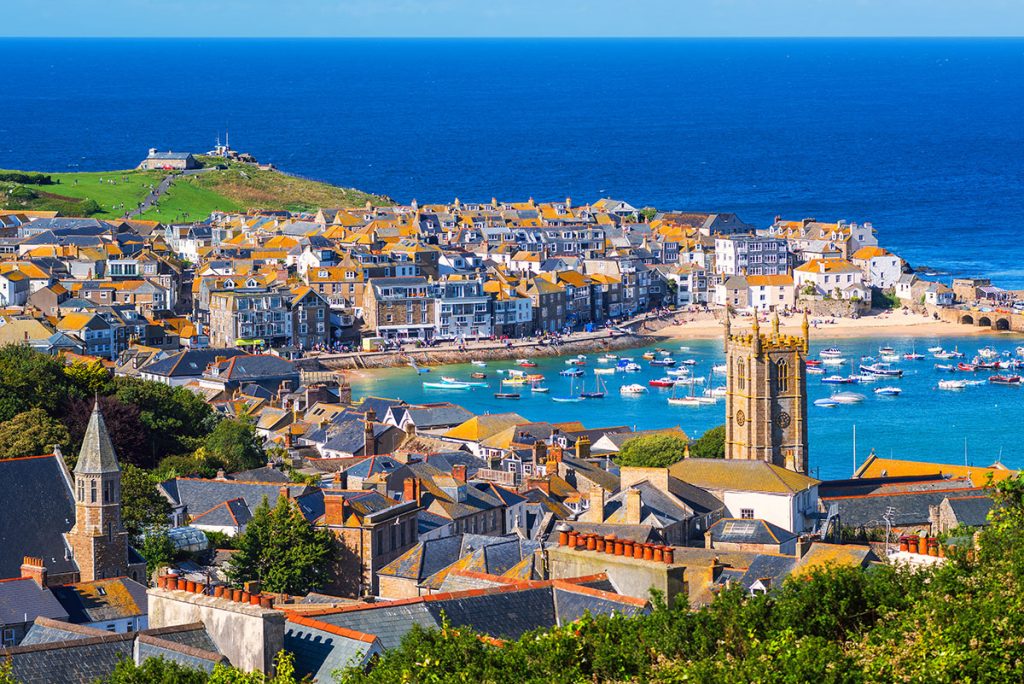
Bright blue water, quaint cottages, bright boats bobbing on the harbour and the sound of squawking seagulls in the air… St Ives is postcard-perfect.
St Ives boasts palm-lined beaches with powdery white sand, but it’s also famous for its arty culture – artists came to the town from all over the UK and Europe because of its natural beauty.
Nowadays, you can visit the TATE art gallery and the Barbara Hepworth Sculpture Gardens to engross in the art scene.
Walk from St Ives town centre to Porthminster Beach, Porthmeor Beach and Carbis Bay Beach – or head further along the bay to Porthkidney Sands.
Another must-do in St Ives is to experience the food scene – visit Blas Burgerworks for delectable burgers, head to Moomaid of Zennor for traditional ice cream, and visit any pasty shop (St Ives Bakery is the most popular) for traditional Cornish pasties!
Click here for all of the things to do in St Ives
How to get there: If you want to do public transport, take a train to St Erth from London, Bristol, Exeter or a few other stations and then change to the scenic branch line. St Ives is one of the furthest west towns in Cornwall and takes around six (or more depending on traffic) hours to drive from London.
16. Zennor

A small village sitting on rocky cliffs, Zennor is hike-able on the South West Coast Path from St Ives. This was one of my favourite walks on the entire path – the clifftop views are immense, although there are a lot of rocky sections where you’ll need to do a little bouldering!
Once you arrive in the village, check out its ancient monuments, such as Zennor Quoit.
Zennor was one of the last areas where locals spoke the Cornish language in the late 18th century – until it was revitalized in the 20th century, that is!
In the small village, enjoy a slap-up dinner at The Tinner’s Arms and venture into the church to see a carving of the Mermaid of Zennor.
How to get there: Take the Land’s End Coaster from St Ives (which is reachable from St Erth on the branch line, and St Erth is connected to London Paddington). Driving to Zennor can be a bit of a headache; the roads are windy and small, and when we drove there once we were held up by cows on the road! The Land’s End Coaster also passes through Penzance, Porthcurno and Land’s End.
17. St Just
The closest settlement to Land’s End, St Just was the centre of the tin mining industry in West Penwith (the far west part of Cornwall)
Granite cottages line the village; there’s not a huge amount to do there, but it’s one of the best places in Cornwall to soak in authentic Cornish culture.
There’s a packed calendar of events in St Just throughout the year: it’s one of the best places to celebrate St Piran’s Day and we saw the Ordinalia, a historic Cornish play, in October 2021.
Pop into Pendeen while you’re in St Just, which is home to red sand cliffs contrasting with bright blue water and the Geevor Tin Mine.
How to get there: The Land’s End Coaster runs through St Just, connecting it with St Ives and Penzance, or there is a large car park in town.
18. Sennen and Sennen Cove

Sennen is a small village sitting on the top of one of West Cornwall’s remote cliffs. With a medieval church and the First and Last Inn with smuggling connections, it’s a lovely spot for a stroll, hearty pub lunch and step back in history.
Once you’ve explored Sennen, head down to Sennen Cove. A bright white beach extending along the West Cornwall coastline, it’s the best place for surfing in this part of Cornwall.
There are safe swimming areas, and a beach cafe is a welcoming spot to enjoy brunch, afternoon snacks or drinks as you watch the sunset.
If you’re feeling intrepid, hike to Pendeen, where you’ll bypass some of the most remote beaches and areas of coastline in the country.
How to get there: The Land’s End Coaster stops in Sennen; you’ll need to walk down to Sennen Cove from here. There’s a large car park in Sennen – again, you’ll need to walk down to the beach.
19. Land’s End
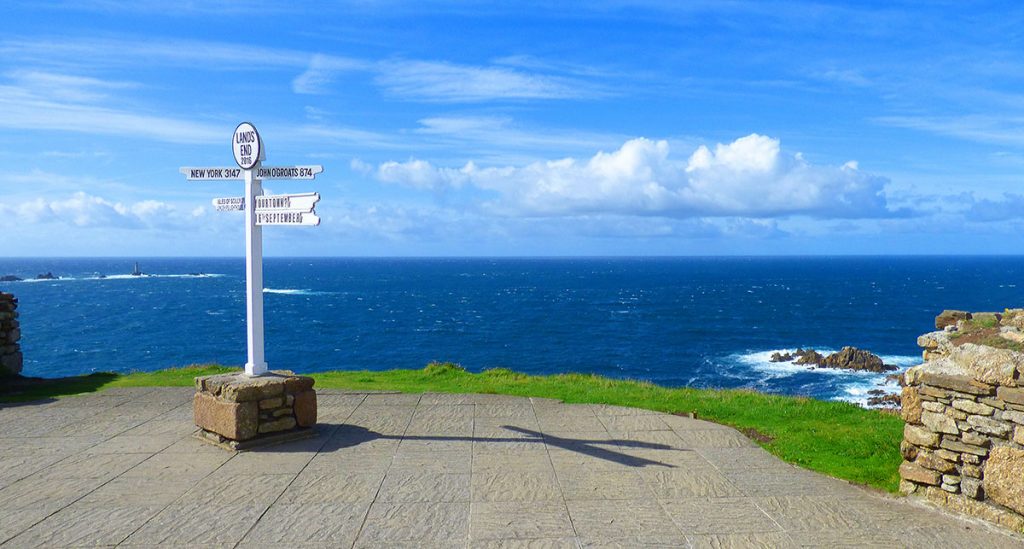
Sitting right in the southwest of the UK, 837 miles from John O’ Groats, Land’s End is striking.
My favourite thing to do here is to gaze out to sea – you can see the Isles of Scilly on a clear day – and walk around to some of the hidden beaches in the area (one of the best is Nanjizal Beach).
If you’re visiting Cornwall with kids, you’ll find plenty to enjoy at Land’s End. Take a whirl on King Arthur’s Quest, explore the Wallace and Gromit Experience or see the animals at Greeb Farm.
There’s also shopping and a few “first and last” experiences at the point too!
Here’s my full guide on the best things to do in Land’s End
How to get there: Of course, the Land’s End coaster stops in Land’s End! It connects the natural landmark to Penzance and St Ives. Many tourists drive, but there is a hefty charge for parking. You could also park in Sennen and walk to Land’s End.
20. Porthcurno

Tucked away in the corner of southwest Cornwall, Porthcurno’s a tiny village that’s most famous for the Minack Theatre, an open-air auditorium that was pretty much dug out by hand in 1932 by a woman called Rowena Cade.
Take a tour of the Minack Theatre, or catch a show if there’s one playing while you’re in Cornwall!
Also, Porthcurno Beach is one of my favourites in the West Country, a sandy bay enveloped by cliffs, and you’ll also find the fascinating Telegraph Museum which is one of the best things to do in Cornwall in the rain.
How to get there: There are a few large car parks, making driving a possibility, or take the Land’s End Coaster from Penzance.
21. Mousehole

With boats bobbing gently on the historic harbour, Mousehole looks like it belongs on a postcard.
The charming fishing village is a favourite spot among tourists and locals; but while its beauty is the main allure, you’ll also step back into centuries of history when you walk around the village.
Mousehole used to be a much more important port than Penzance or Newlyn, but was burned to the ground by Spanish invaders in 1595 – all buildings but one date back to after this time.
It was a smuggler’s haven, it’s where Stargazy Pie (a fish pie containing full fish, their heads looking up to the sky) was created and it was where the tragic Penlee lifeboat disaster took place.
You can learn about Mousehole on a guided tour of the village with Elaine, a village local; she’ll make the place come to life with all of her stories and information!
Here is my complete guide to Mousehole
How to get there: I wouldn’t recommend driving to Mousehole; the roads are narrow and winding, and it can be challenging to find parking. Instead, park in Penzance harbour and take the M6 bus to Mousehole.
22. Penzance

While Penzance was a popular tourist hub in the 19th century, it’s not as popular nowadays; but it sits at the end of the GWR main line and has a few fun attractions making it worth popping into!
You can even get the sleeper train from Paddington to Penzance!
Chapel Street is lined with historically significant buildings, including the pubs The Turk’s Head and Admiral Benbow and the house where Maria Bramwell, the mother of the Bronte sisters, grew up!
Visit Newlyn for seafood and art, or stay around in Penzance for the Penlee House Gallery and Museum.
Or, you could take a dip at the harbour, or venture further east to beach towns like Praa Sands.
Check out the best things to do in Penzance here!
How to get there: Either take the train from London Paddington, Bristol or a few other towns in Cornwall, or drive and park in the vast harbour car park.
23. St Michael’s Mount
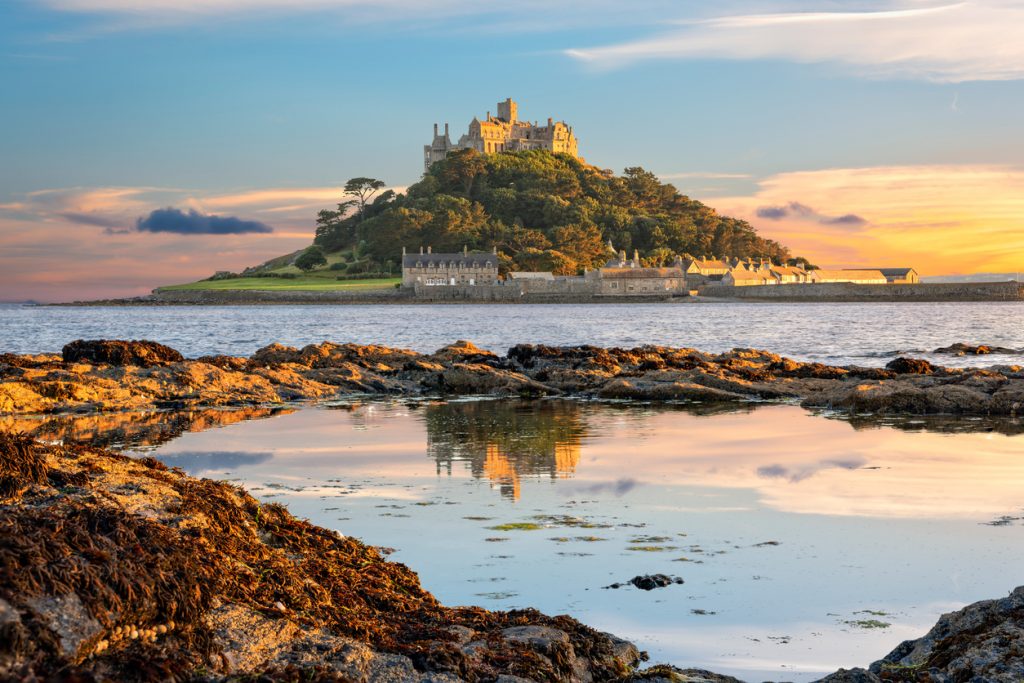
St Michael’s Mount is a tidal island with a Medieval church and castle on top.
A National Trust property, it’s the Cornish version of Mont St Michel in Normandy; both are set on tidal islands.
The island is only accessible on certain days of the month; the tidal causeway is accessible on even fewer days! However, you can take a boat over on other days.
Marazion is the closest town. Marazion Beach is ever-popular and the view over to St Micheal’s Mount is immense.
See my full blog post about St Micheal’s Mount here
How to get there: Buses connect St Micheal’s Mount with Penzance, or there are a few places to park.
24. Porthleven

Nestled into the northwest corner of the Lizard Peninsula, Porthleven is one of the most attractive harbour towns in Cornwall and is the furthest south working port in the UK.
The harbour dates back to 1811, and it’s lined with gorgeous 19th-century buildings. Take a stroll around the pretty harbour, enjoying the boats, grabbing an ice cream at Nauti But Nice as you stroll!
How to get there: There are buses from Helston or Penzance, or a few car parks for drivers.
25. The Lizard

I wouldn’t go so far as to call The Lizard a hidden gem (although parts of the peninsula are), but this jagged stretch of land extending into the sea is, without a doubt, one of the most spectacular areas of not only Cornwall but the whole of the UK.
Sitting right at the tip, there’s Lizard Point, which is the most southerly in the country. Extending from Lizard Point in either direction, you’ll find epic coastline including the famous Kynance Cove – this is one of the best stretches of the South West Coast Path.
It’s quite isolated, but don’t miss The Lizard if you want to visit somewhere with outstanding beauty and unforgettable views.
It’s also worth venturing to the nearby Gweek Seal Sanctuary where rescued seals are rehabilitated and rehomed, to the Museum of Cornish Life at Helston and the Trebah Subtropical Gardens.
See my full guide to the Lizard Peninsula here, or click here for the best Lizard beaches!
How to get there: The A3083 extends all the way down to Lizard Point, with minor roads branching off to the main attractions on the east and west coast. If you’re taking public transport, there is a Lizard Coaster Bus from Helston, although it doesn’t visit all of the best Lizard attractions.
26. Falmouth

Falmouth’s not as historic as Cornwall’s abundant fishing villages and charming cobblestone towns, but that’s not to say it doesn’t have history.
Pendennis Castle, a fortification sitting just outside of town, was built first; Henry VIII it to protect the River Fal and Cornwall from foreign invasion, and it was also crucial in the Civil War. Nowadays, it’s run by the English Heritage and is one of the best castles to visit in Cornwall.
Falmouth built up in Elizabethan times thanks to the local Killagrew family, who were Cornish nobility but ultimately a family of pirates. It became one of the most important shipping towns in the world at the time, thanks to its deep natural harbour (the third deepest in the world).
You can explore all of this on a visit to the town’s expansive National Maritime Museum, which describes Falmouth’s origins, the Falmouth packet which was the message-carrying service that ran through the town and modern Falmouth harbour.
In town, you’ll find boat trips around the harbour and over to St Mawes, an abundance of excellent international restaurants (Falmouth’s always had a global food scene) and lots of fun bars (it’s Cornwall’s only university town!).
Check out all of the best things to do in Falmouth by clicking here
How to get there: Take a train to Truro and then change to the Falmouth branch line, or drive and park in town (I’ve found free parking close to Pendennis Castle before).
27. Truro

The only city in Cornwall, Truro is renowned for its Bath stone covered Georgian buildings and three-spired cathedral; the only in the county.
It’s free to visit and walk around Truro Cathedral, which only dates back to the late 19th century but stands as a proud Cornish landmark.
Also, don’t miss the Royal Museum of Cornwall, which looks at Cornwall’s unique history and culture. This is probably my favourite museum of Cornwall; they explain Cornish heritage in a comprehensive and enlightening way.
Truro’s popular with locals for shopping, and you can also take cruises down the Fal Estuary, cycle around the city or enjoy some excellent restaurants – I love Hub Box, a burger restaurant located in a former church.
You can see all of the things to do in Truro here
How to get there: Truro has a train station that’s connected to the main Cornwall line that leads to London and Bristol. There are a few car parks throughout the city.
28. Mevagissey

Mevagissey is a traditional fishing village that has long been the centre of Cornwall’s pilchard trade and has an expansive history of boat-making.
It’s one of my favourite towns in Cornwall to get a slice of local life; I enjoy walking around the harbour, checking out the numerous landmarks, and walking through the narrow streets.
A fantastic base for the Eden Project or the Lost Gardens of Heligan, Mevagissey does get popular in school summer holidays, but the rest of the year it’s a charming, laid-back town.
How to get there: Driving’s the best way, which means that the car parks of Mevagissey can be packed in the peak summer season!
29. St Austell

The historic market town of St Austell itself, located slightly inland, isn’t all that exciting on its own- although it is home to the famous St Austell Brewery; tours are sometimes on offer although I’ve never managed to secure one!
However, it’s worth visiting for the stunning natural surroundings. Just a short distance to the Cornish Riviera, with beaches like although there are some beautiful beaches nearby. Head to Porthpean or Polkerris Beach to see what I mean!
This makes it a popular place with families; it’s also much-loved thanks to its proximity to family attractions like the Eden Project, Lost Gardens of Heligan and the Wheal Martyn Mine Museum.
Check out the best things to do in St Austell
How to get there: The Cornish mainline train plys into St Austell, or there are plenty of car parks.
30. Charlestown
Sitting 1.5 miles from St Austell, you’ll find the UNESCO harbour of Charlestown, an 18th-century port that looks as if it’s been frozen in time.
Visit to see the tall ships that bob in the harbour, see filming locations from various hit TV shows and movies (Poldark and many films were recorded here!), or do a walking tour to see some of Charlestown’s highlights.
Most tourists only visit Charlestown for a day, but with plenty of restaurants and pubs, it’s also a fantastic place to base in and see the best attractions of South Cornwall!
How to get there: Take a bus from St Austell or drive; although parking can be limited (I’d recommend finding parking on the roads above the village).
31. Fowey

Beautiful beaches, the peaceful Fowey River, and plenty of history – Fowey is one of the best places to go to in Cornwall for a relaxing holiday.
There are tonnes of attractions in Fowey. Visit Readymoney Cove for a slightly hidden beach and hike up to the ruins of the Tudor St Catherine’s Castle.
In town, walk along the pastel-coloured esplanade, visit Fowey Museum or head out on the Fowey River, either on a boat tour or by paddleboard or kayak, and pass the former home of Daphne Du Maurier.
Bufala is my favourite place to eat in Fowey; it serves up mouthwatering artisanal pizzas and encompasses beautiful views of the town from its terrace.
How to get there: take a bus from St Austell, or drive and park in the car park above the village.
32. Polperro

Think of a traditional Cornish fishing town, and Polperro may immediately spring to mind.
A beautiful harbour awaits you as you venture into Polperro – either inland or from the South West Coast Path.
Spend some time getting lost in the streets, perhaps visiting the Polperro Museum to learn about smuggling in the area or shopping at some of their quirky shops – get some treats for your pooch at The Doghouse Deli and Bar or try some extra-hot chilli sauce at the Cornwall Chilli Company!
The Blue Peter Inn is a cosy pub offering hearty food and drink, sitting just above the harbour. Visit the small beach if the tide’s out, and try to find Willy Wilcox Cave, a notorious ex-smuggling cavern.
Here’s my full guide to Polperro
How to get there: There’s a large car park on the main road – from here, you’ll need to walk down to the village. Alternatively, leave your car at Looe, where there’s a large car park, and take the bus.
33. Looe

Sitting on the Looe Estuary, the town of Looe extends out to sea, terminating in East Looe Beach on one site and Hannafore Point on another. The coastal path ultimately leads to Polperro; it’s a fairly easy five mile walk that’s one of my favourites on the coast path (and you can take a bus back!).
One of the best spots for family holidays in Cornwall, nearby attractions include the Monkey Sanctuary, Adrenalin Quarry and numerous beaches.
Also, don’t miss day tripping out to Looe Island, which you can see from the mainland. Owned by the Cornwall Wildlife Trust, Looe Island has unique flora and compelling history.
Back in town, visit smuggling pubs, the Old Guildhall Museum and Gaol and a variety of independent shops.
Here’s my full guide to visiting Looe
How to get there: Looe is easily drivable from Plymouth or other parts of Devon and East Cornwall, but you could also take the train to Liskeard and then hop on the pretty branch line that extends down to the coastal town.
34. The Rame Peninsula

Ahh, the Rame Peninsula. I almost don’t want to talk about this spectacular part of Cornwall too much; as its solitude and isolation is what makes it so special. But, there’s no way I can leave it off this best places to visit in Cornwall list, as it’s one of my favourites!
Known as “forgotten Cornwall”, the Rame Peninsula sits nestled in the far southeast segment of the region. It’s a little trickier to get to than other spots on this list, which lends to its isolation.
The villages of Cawsand and Kingsand have charming beaches and beautiful historic buildings. You can hike from here to Rame Head, the terminus of the peninsula, or over to Cremyll and Mount Edgecumbe, which sits just opposite Plymouth.
How to get there: Most visitors drive, but you can take a boat from Royal William Yard in Plymouth to Cremyll throughout the year; and in the summer, there’s a direct boat service to Cawsand and Kingsand.
35. Launceston

The old county town of Cornwall, Launceston is only just over the Tamar from Devon but it has a very strong Cornish spirit and is a great place to learn about the Duchy’s Celtic origins.
Do this by visiting Launceston Castle, one of Cornwall’s Norman fortifications, which dates all the way back to the 11th century.
Find charming independent shops and a historic church in Launceston High Street and take in the wonderful Tamar scenery.
Launceston is situated on the two castles route which runs from Okehampton. It’s also close to places like Gunnislake and Calstock on the Tamar Valley, a beautiful riverside walking trail that marks the border between Cornwall and Devon.
Here’s my full guide to Launceston
How to get there: Conveniently located just off the A30, Launceston is the perfect stopover for anyone driving into Cornwall.
Amazing places to go on holiday in Cornwall!
Beaches, Celtic history, mining heritage, rich food, brooding moorland… there are so many reasons to visit Cornwall.
With this guide, you’ll be able to discern which place is most suitable for you and your travel group – and start booking your accommodation!
I have in-depth articles on most of these destinations on my Cornwall travel blogs section of this website. If you have any specific questions, feel free to reach out on Instagram!
Was this post helpful?
If I’ve helped you plan your trip to South West England, I’d really appreciate it if you use my affiliate links or make a small contribution to help me continue to produce up-to-date content.
You can buy me a coffee by clicking this link.


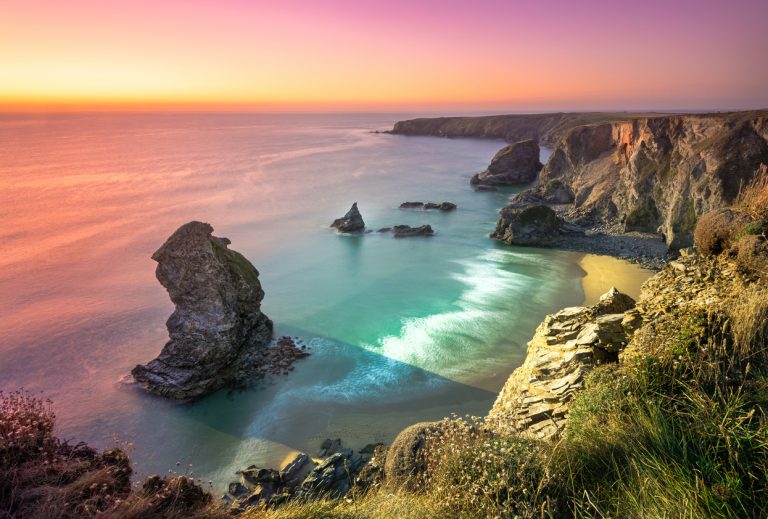

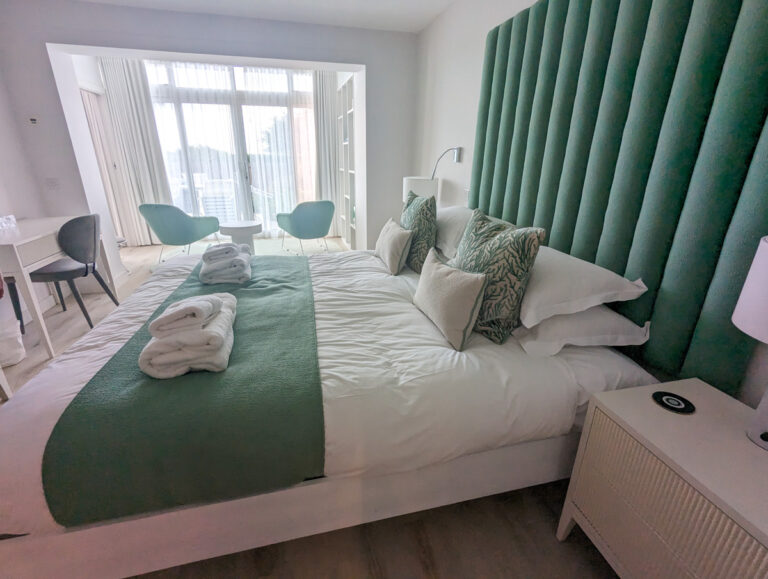
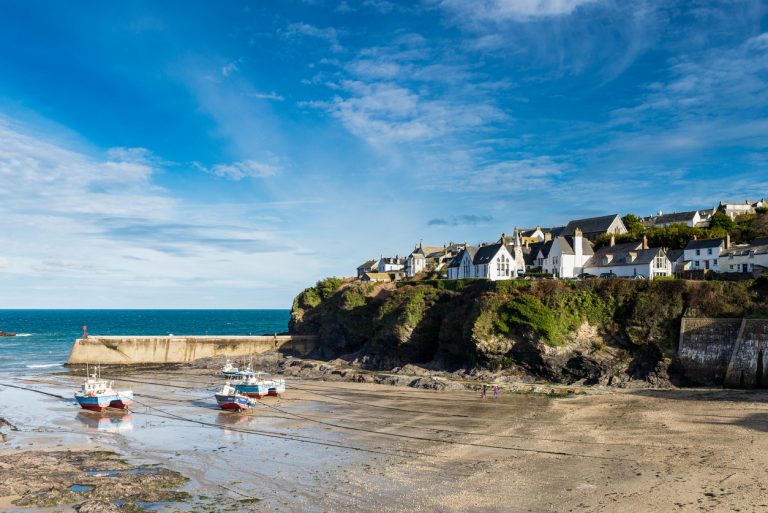

Very informative and helpful for planning my 1st visit to Cornwall, thanks.